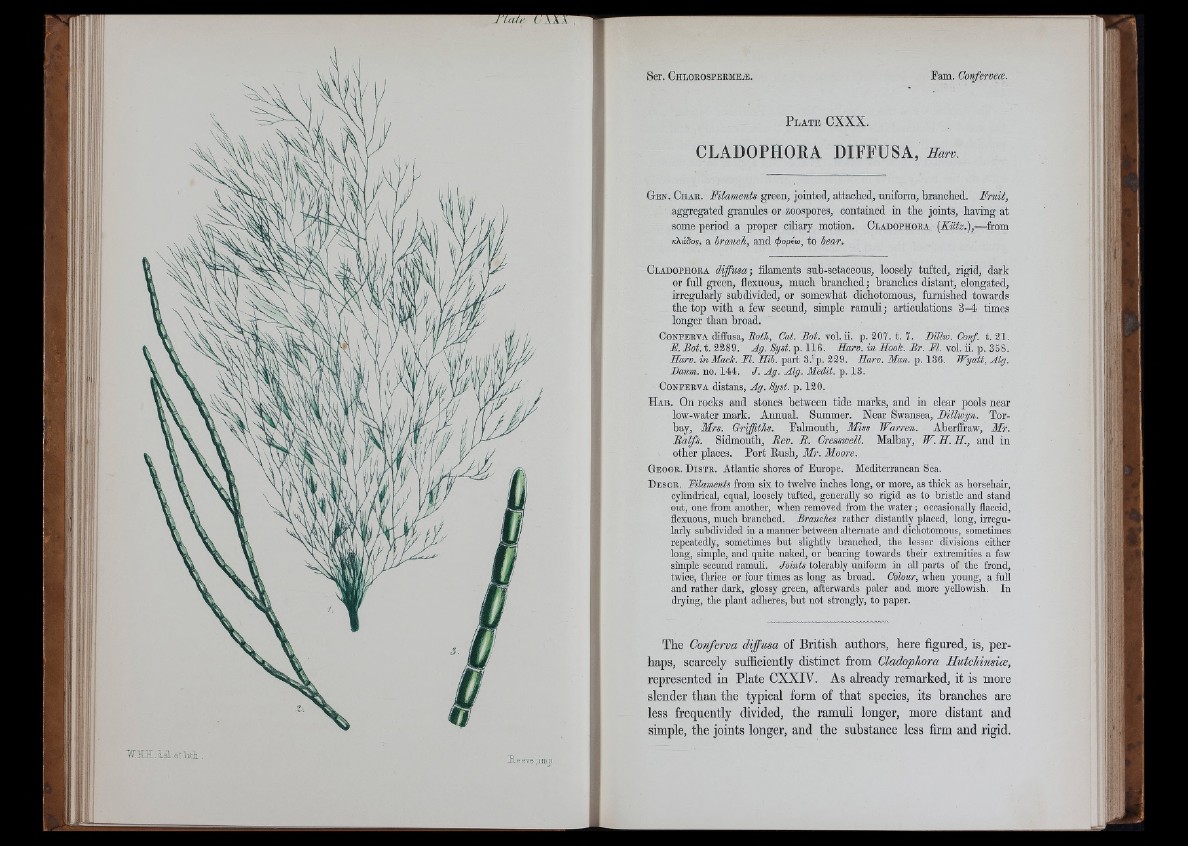
He. V6 ,rrnj3.
Ser. Chloeospbkmeye. Pam. Gonferveæ.
P l a t e CXXX.
CLADOPHORA DIFFUSA, Haro.
G e n . C h a e . Filaments green, jointed, attached, uniform, branched. Fruit,
aggregated grannies or zoospores, contained in the joints, having at
some period a proper ciliary motion. C l a d o p h o e a (Kiitz.),—from
K\dSos, a hrauch, and ^opeco, to hear.
C l a d o p h o e a diffusa-, filaments sub-setaceous, loosely tufted, rigid, dark
or fuU green, flexuous, much branched; branches distant, elongated,
irregularly subdivided, or somewhat dichotomous, furnished tow'ards
the top with a few secund, simple ramuli; articulations 3 -4 times
longer than broad.
Coneekva diifusa, Roth, Cat. Bot. vol. ii. p. 207. t. 7. Dillw. Conf. t. 21.
E . Bot. t. 2289. Ag. Syst. p. 116. Harv. in Hook. Br. El. vol. ii. p. 358.
Harv. in Mack. El. H ii. part 3.’p. 329. Harv. Man. p. 136. Wyatt, Alg.
Banm. no. 144. J. Ag. Alg. Medit. p. 13.
CoNEEEVA distans, Ag. Syst. p. 120.
H a b . On rocks and stones between tide marks, and in clear pools near
low-water mark. Annual. Summer. Near Swansea, Billmyn. Torbay,
Mrs. Grifftlis. Falmouth, Miss Warren. Aberffraw, M r.
R a lfs . Sidmouth, R ev. R . Cressmell. Malbay, W. H . H ., and in
other places. Port Rush, M r. Moore.
Geoge. D is t e . Atlantic shores of Europe. Mediterranean Sea.
D e sc e . Eilaments from six to twelve inches long, or more, as thick as horsehair,
cylindrical, equal, loosely tufted, generally so rigid as to bristle and stand
out, one from another, when removed from the water; occasionally flaccid,
flexuous, much branched. Branches rather distantly placed, long, irregularly
subdivided in a manner between alternate and dichotomous, sometimes
repeatedly, sometimes hut slightly branched, the lesser divisions either
long, simple, and quite naked, or bearing towards their extremities a few
simple secund ramuli. Joints tolerably uniform in aU parts of the frond,
twice, thrice or four times as long as broad. Colour, when young, a full
and rather dark, glossy green, afterwards paler and more yellowish. In
diying, the plant adheres, but not strongly, to paper.
The Conferva diffusa of British authors, here figured, is, perhaps,
scarcely sufficiently distinct from Cladophora Hutchinsice,
represented in Plate CXXIV. As already remarked, it is more
slender than the typical form of that species, its branches are
less frequently divided, the ramuli longer, more distant and
simple, the joints longer, and the substance less firm and rigid.